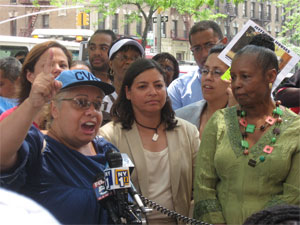Today I listened to a segment on Democracy Now! about a new report that’s out from Demos and Brandeis University on the state of the Black and Latino middle class in the United States. The study, entitled “Economic (In)Security: The Experience of the African American and Latino Middle Classes,†finds that three-out-of-four Black and four-out-of-five Latino middle-class families are economically insecure and at high risk of slipping out of the middle class. From the report, which can be downloaded as a PDF from the Demos website:
African-American and Latino families have more difficulty moving into the middle class, and families that do enter the middle class are less secure and at higher risk than the middle class as a whole. Overall, more African-American and Latino middle-class families are at risk of falling out of the middle class than are secure. This is in sharp contrast to the overall middle class, in which 31 percent are secure and 21 percent are at risk. Specifically:
- Only 26 percent of African-American middle-class families have the combination of as- sets, education, sufficient income, and health insurance to ensure middle-class financial security. One in three (33 percent) is at high risk of falling out of the middle class.
- Less than one in five Latino families (18 percent) is securely in the middle class. More than twice as many (41 percent) of Latino families are in danger of slipping out of the middle class.
- African-American middle-class families are less secure and at greater risk than the middle class as a whole on four of the five indicators of security and vulnerability [named by the report as assets, education, housing, budget, and healthcare]. Latino middle-class families are less secure and at greater risk on all five indicators.
Jennifer Wheary, a senior fellow at Demos and one of the co-authors of the report, elaborated on Democracy Now!:
And what we found was when we compared the situation of white middle-class families to African Americans and Latinos, there were vast differences. You know, and what was astounding to us was really looking at—these are, you know, African American and Latino families that, by all sense and purposes, have achieved the American dream, people who, you know, have two earners, two professional earners in the household, you know, maybe are trying to own a home or do own a home, you know, very—have achieved all the aspirations that we typically go for. But even among those people, when you look at, you know, where they’re weak economically, we found that about two-in-five Latino middle-class families are in danger of falling out of the middle class. They’re so financially vulnerable, don’t have assets. Maybe somebody in the household is uninsured. And one-in-three African American middle-class families are also in danger, so vulnerable, so weak, that they’re in danger of falling out of the middle class.
I haven’t read the report yet, but when I do, I fully expect to cry. In fact, as I listened to the segment on the bus home today, I actually found myself tearing up; not only because the larger injustices behind what I was hearing, but because it hit a very personal chord.
Continue reading ‘Blacks, Latinos, and the precariousness of “middle class”’

